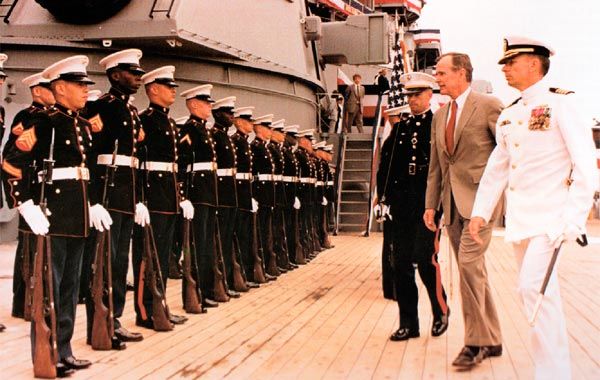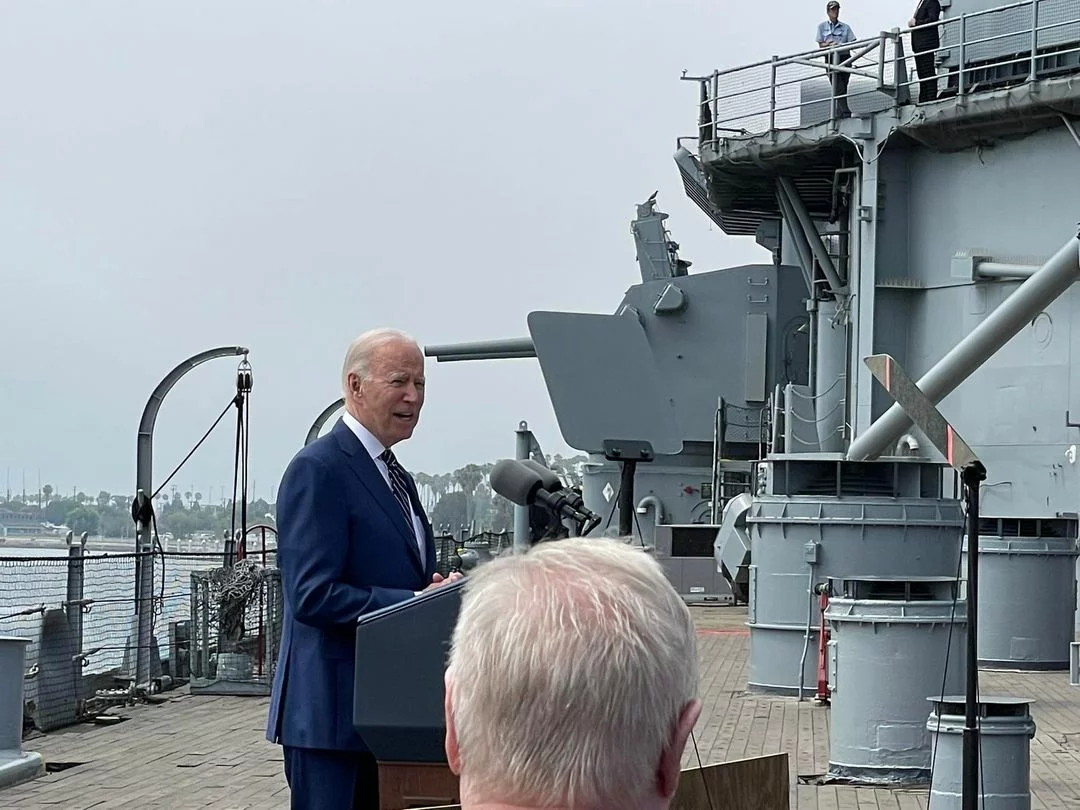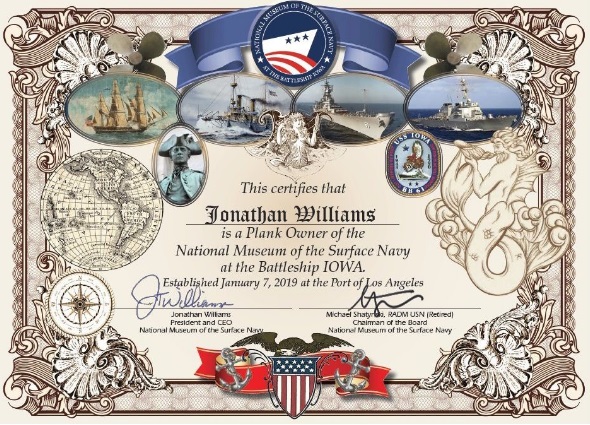A Presidential Legacy at Sea
From a secret World War II mission with President Franklin D. Roosevelt, to a Cold War recommissioning under Ronald Reagan, memorial tributes by George H. W. Bush, and addresses by Donald J. Trump and Joseph R. Biden Jr., USS Iowa has long stood at the crossroads of American leadership and global events. She remains the only U.S. battleship to serve multiple Presidents — not just as a warship, but as a trusted platform for diplomacy, remembrance, strength, and national purpose.
A Name with National Weight
Legend holds that USS Iowa was named in part due to Vice President Henry Wallace — a proud Iowan and champion of American agriculture — and that President Roosevelt personally sketched early concepts of the Iowa-class on the back of a napkin. Since then, the ship and her namesake state have remained closely tied to presidential presence. From President Donald J. Trump’s public foreign policy announcement aboard her deck to President Joe Biden’s 2022 speech on maritime trade and global supply chains, Iowa continues to represent strength, symbolism, and a nation’s enduring reliance on freedom of the seas.
“…from all I have seen and all I have heard, the Iowa is a ‘happy ship,’ and having served with the Navy for many years, I know, and you know, what that means.”
— President Franklin D. Roosevelt, December 1943
President Franklin D. Roosevelt
A Secret Wartime Voyage
On November 12, 1943, President Franklin D. Roosevelt boarded the USS Iowa from the presidential yacht USS Potomac at the mouth of the Potomac River. Accompanied by key advisor Harry Hopkins and members of his War Cabinet, Roosevelt was en route to a top-secret Allied summit with British Prime Minister Winston Churchill and Soviet leader Joseph Stalin — the Tehran Conference.
Just days into the voyage, Roosevelt requested a demonstration of Iowa’s combat readiness. The crew conducted a live anti-aircraft drill, joined by nearby escort ships. During the exercise, the destroyer USS William D. Porter, one of Iowa’s escorts, accidentally launched a live torpedo directly at the battleship.
Initial attempts to signal Iowa using a blinker light failed. In a dramatic move, Porter broke radio silence — a wartime taboo — to warn of the danger. Iowa turned hard to starboard, narrowly avoiding the torpedo, which detonated harmlessly in her wake.
President Roosevelt, upon learning of the incoming torpedo, famously asked to be wheeled to the ship’s side so he could watch.
Iowa successfully completed the mission and returned Roosevelt safely to the U.S. on December 16, 1943. Before departing, the President addressed the crew with a compliment sailors still remember:
“…from all I have seen and all I have heard, the Iowa is a ‘happy ship,’ and having served with the Navy for many years, I know, and you know, what that means.”
Read more about this extraordinary voyage in an article from Patriot’s Point ➝
“…to chart one’s own course and take the adventure of life as it comes; to be free as the wind — as free as the tall ships themselves.”
— President Ronald Reagan, July 4, 1986
President Ronald Reagan
Liberty Weekend Aboard USS Iowa
During the 1980s, President Ronald Reagan launched an ambitious plan to restore American naval strength. His goal: build a 600-ship Navy capable of projecting peace through power across the globe during the height of the Cold War. As part of this vision, all four Iowa-class battleships — including USS Iowa — were pulled from the reserve fleet and modernized for active duty.
In 1984, Iowa was recommissioned with state-of-the-art upgrades, including Tomahawk cruise missiles, Harpoon launchers, and advanced combat systems — a blend of World War II might and modern deterrence. Reagan saw these ships not just as warfighting platforms, but as powerful symbols of American resolve.
On July 4, 1986, President Reagan and First Lady Nancy Reagan boarded Iowa during Liberty Weekend, a national celebration honoring the centennial of the Statue of Liberty in New York Harbor. That morning, Iowa served as the presidential viewing platform for a massive international naval review. As the ships passed in formation, Reagan offered a reflection on their deeper meaning.
The day concluded with a concert by The Beach Boys, who performed atop Iowa’s Turret 3 for the ship’s crew, their families, and invited guests — a fitting end to a day that celebrated freedom, strength, and American spirit aboard the Battleship of Presidents.
“They came to the Navy as strangers; served the Navy as shipmates and friends; and left the Navy as brothers in eternity. In the finest Navy tradition, they proudly served on a great battleship — the ‘Mighty I.’”
— President George H. W. Bush, April 24, 1989
President George H.W. Bush
From Recommissioning to Remembrance
On April 28, 1984, then–Vice President George H. W. Bush presided over the recommissioning of USS Iowa at Ingalls Shipyard in Pascagoula, Mississippi. His presence marked a significant moment in the Reagan administration’s naval buildup, reaffirming the ship’s return to service as part of the 600-ship Navy initiative.
Five years later, now as President, George H. W. Bush returned to Iowa’s story under far more somber circumstances.
On April 24, 1989, following the tragic Turret 2 explosion that claimed the lives of 47 sailors, President Bush attended a memorial service in Norfolk, Virginia. There, he stood with the crew and grieving families to honor those lost, offering words of comfort, remembrance, and gratitude for their service aboard what he called a great American battleship.
This moment reflected the deeper legacy of Iowa — not just as a recommissioned symbol of strength, but as a ship bound by the sacrifice, courage, and brotherhood of those who served aboard her.
“We’re going to make our military so strong that nobody’s going to mess with us.”
— Donald J. Trump, USS Iowa, September 14, 2015
President Donald J. Trump
USS Iowa as a Platform for National Defense
On September 14, 2015, during his campaign for the presidency, Donald J. Trump spoke aboard USS Iowa at a national defense-themed rally hosted by Veterans for a Strong America. Taking place on the ship’s fantail and framed by her iconic 16-inch guns, the event brought attention to the importance of military strength, American leadership, and honoring those who serve.
Speaking to an audience of veterans and supporters, Trump emphasized rebuilding the U.S. armed forces and projecting American strength abroad. The moment was one of visibility and symbolism — linking the nation’s future to its storied maritime past.
The event reflected a long-standing tradition — where USS Iowa has served not only as a formidable naval vessel, but also as a stage for presidential presence, national remembrance, and the enduring projection of American values.
“Thanks to America’s leadership and diplomacy, we’ve helped Europe reduce its reliance on Russian oil… and we’re working with our partners to unblock grain exports trapped in Ukraine — efforts that move through ports, across oceans, and affect prices around the world.”
— President Joseph R. Biden Jr., USS Iowa, June 10, 2022
President Joseph R. Biden
Addressing Economic Challenges
On June 10, 2022, President Joe Biden visited the Port of Los Angeles to discuss pressing economic issues, including inflation and supply chain disruptions. Choosing the deck of the historic Battleship USS Iowa as his platform, the President underscored the significance of maritime commerce and national infrastructure in addressing these challenges.
During his remarks, President Biden emphasized the need to strengthen the nation’s supply chains and reduce costs for American families. He highlighted legislative efforts aimed at curbing excessive fees by foreign-owned shipping companies and improving port operations. The President also acknowledged the hard work of port workers and the importance of the maritime industry in the nation’s economic recovery.
The USS Iowa, having served as a backdrop for multiple presidential events throughout its history, once again stood as a symbol of American resilience and leadership. President Biden’s address from its deck continued the tradition of utilizing this storied battleship as a stage for significant national conversations.
15-Days as First Pet
Vicky’s Presidential Voyage

In November 1943, USS Iowa became more than a battleship — it became a floating White House. As the ship carried President Franklin D. Roosevelt across the Atlantic on a top-secret mission to the Tehran Conference, it also played host to one of its most beloved crew members: Vicky, the ship’s mascot.
Vicky typically slept at the foot of Captain John L. McCrea’s bed, but when Roosevelt came aboard, the captain offered to relocate Vicky. The President, known for his affection for dogs, famously replied:
“Well John, I see no reason to disrupt this little dog’s routine.”
And so, for 15 extraordinary days, Vicky remained in the Captain’s Cabin — sleeping at the foot of the President’s bed, a position few can claim.
Vicky’s time aboard was filled with presidential privilege. Vicky attended nightly film screenings with Roosevelt and his staff, wandered the passageways where early discussions of the D-Day invasion were taking shape, and posed for photographs with dignitaries and officers alike. Whether quietly tucked beneath a table during high-level briefings or playfully greeting crew members, Vicky was part of history in motion.
Today, visitors can still trace those unforgettable days:
- See the custom-built bath tub installed just for President Roosevelt.
- Stand beside the chair used to hoist the President aboard the ship.
- And for younger guests — find Vicky as part of a kid-friendly scavenger hunt throughout the ship!
From wartime voyages to museum memories, Vicky’s story remains a favorite — a reminder that even on the world stage, companionship, loyalty, and routine have their place.





